Court sports demand split-second reactions and lightning-fast direction changes. These moments can easily decide whether you win or lose a point.
Improving your court speed and agility is essential for excelling in competitive games.
Whether you’re into tennis, basketball, or volleyball, your ability to pivot, accelerate, and decelerate quickly matters a lot. It determines how well you reach tough shots and outmaneuver your opponent.
Incorporating drills that focus on court speed and agility will enhance your game.
Improving your court speed and agility will help you dominate in tennis, basketball, or volleyball, ensuring you outpace your opponents.
Many athletes find their court speed and agility directly impacts their performance.
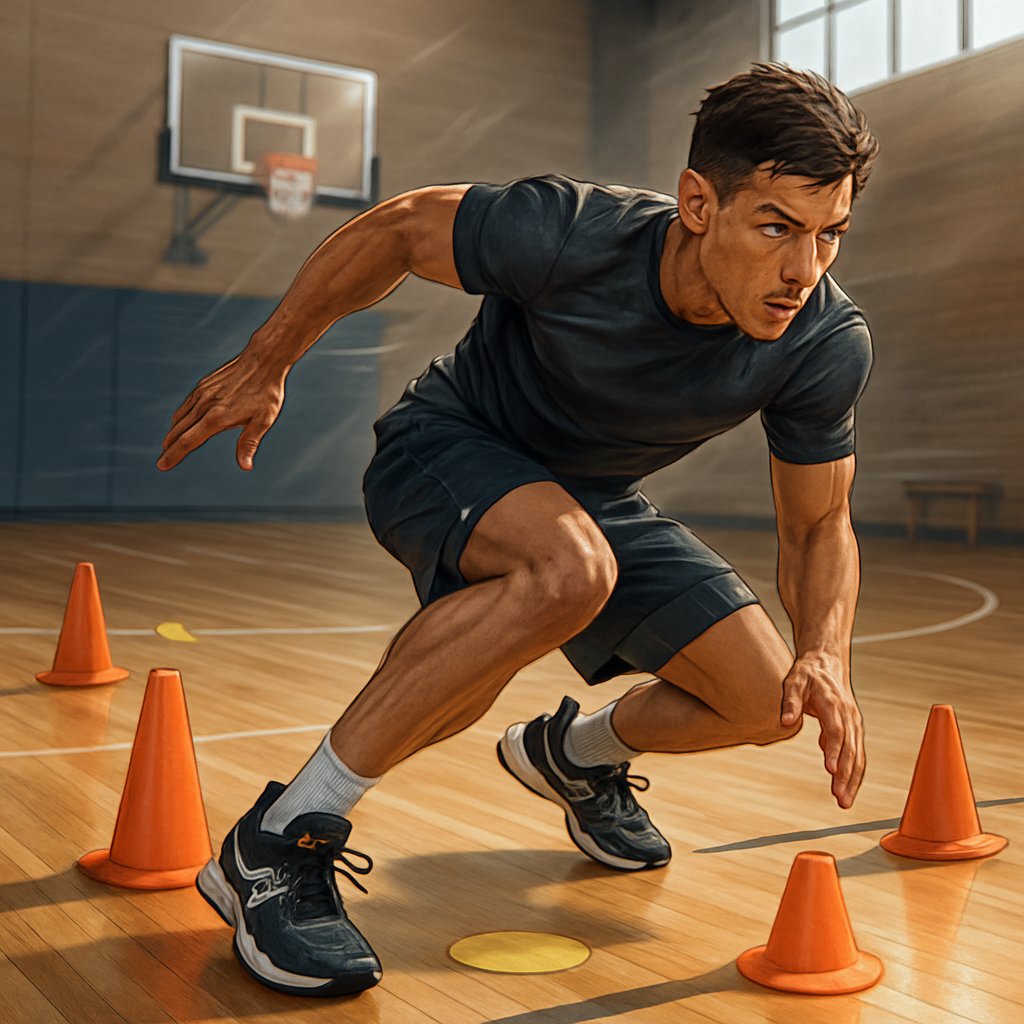
Targeted agility training—think ladder drills, cone work, and plyometrics—can seriously boost your court speed and agility, essential for sports performance. If you practice consistently, you might notice improvements in your court speed and agility in just a few weeks.
These exercises are specifically designed to boost your court speed and agility.
These drills train your body to create explosive power while keeping balance and control during those rapid changes of direction.
The trick is realizing court agility isn’t just about running fast. It’s about syncing your feet, core, and upper body for smooth transitions so you’re always ready for the next move.
To really maximize your court speed and agility, practice regularly with targeted drills.
Focus on the right movement patterns and build muscle memory. That way, you can transform your performance and maybe get a real edge over your competition.
Key Takeaways
- Court agility training needs drills that build quick footwork, explosive power, and sharp direction changes.
- Consistent work with ladders, cones, and plyos builds muscle memory for faster reactions.
- Good training mixes speed with injury prevention for long-term performance.
Fundamentals of Court Speed and Agility
Understanding the fundamentals of court speed and agility will help you improve quicker.
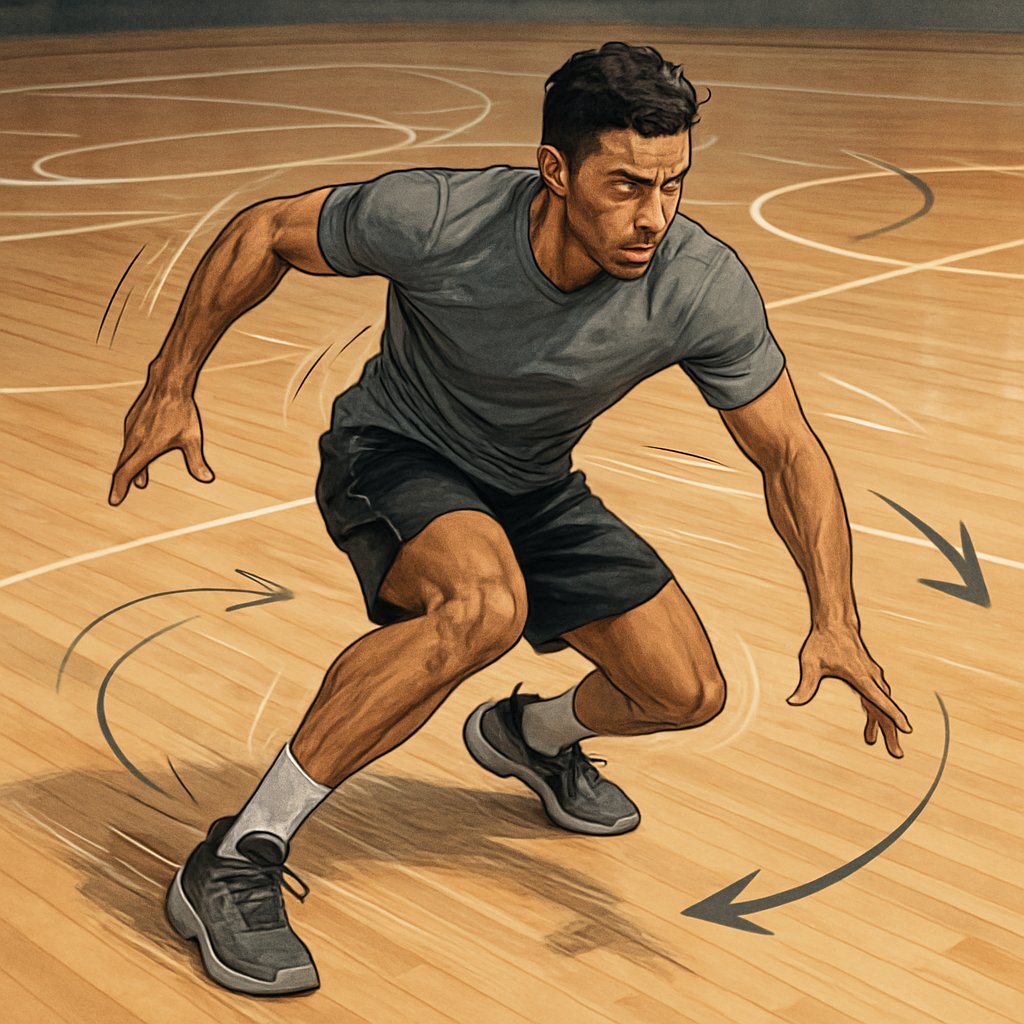
Court sports require movement skills that mix quick direction changes, rapid acceleration, and split-second decisions. These elements create movement patterns you need on the court.
Improving your court speed and agility is key to outmaneuvering opponents.
Defining Agility and Change of Direction
Agility means you can change direction quickly while staying balanced and in control. That’s different from plain speed, which is just how fast you go in a straight line.
Practicing court speed and agility drills will help you stay balanced during games.
Change of direction brings together a handful of skills. You need acceleration to get moving fast, deceleration to slow down before you turn, and coordination to keep your balance as you transition.
True agility includes:
- Physical movement skills
- Reacting to what’s happening around you
- Making decisions under pressure
Change of direction drills focus on the movement itself. Agility training throws in reactive elements, so you’re mimicking real game situations.
Both types of training help your court performance, but in their own ways.
Key Movement Patterns on the Court
Effective training for court speed and agility includes mastering these movement patterns.
Court sports have movement patterns that show up again and again. Mastering these is the foundation for covering the court well.
Main movement patterns:
- Forward and backward sprints – For charging to the net or dropping back
- Lateral shuffles – Moving side-to-side along the baseline
- Diagonal cuts – Angling to corners or chasing tough shots
- Pivot turns – Reversing direction in a flash
Tennis players use all these patterns in a single rally. You might shuffle left, sprint up, then cut diagonally for a drop shot—all in one point.
Each pattern taps different muscles and skills. Lateral moves need strong hips. Sprinting forward is all about leg drive. Diagonal cuts take coordination between your upper and lower body.
Your training should hit all these patterns. Mix up the speed and combinations to keep it real.
The Role of Reaction Time and Decision Making
Focus on enhancing your court speed and agility to increase your competitive advantage.
Reaction time is how fast you respond to your opponent’s moves. The quicker you react, the more time you have to get to the ball and set up your shot.
Enhancing your court speed and agility is vital for athletes in all sports, as it allows for quicker reaction times and better overall performance.
Reaction time has two parts:
- Recognition – Spotting and understanding what’s happening
- Response – Actually starting your movement
You make decisions during the recognition phase. You have to figure out where the ball’s headed and pick your move. Top players do this faster and with fewer mistakes.
You can train both parts. Visual drills help you spot ball flight sooner. Reactive exercises push you to make quick choices under pressure.
A faster reaction really does help you cover the court better. Even tiny improvements add up to more shots reached and better positioning.
Essential Movement and Stability Skills
Your ability to maintain court speed and agility is crucial for effective gameplay.
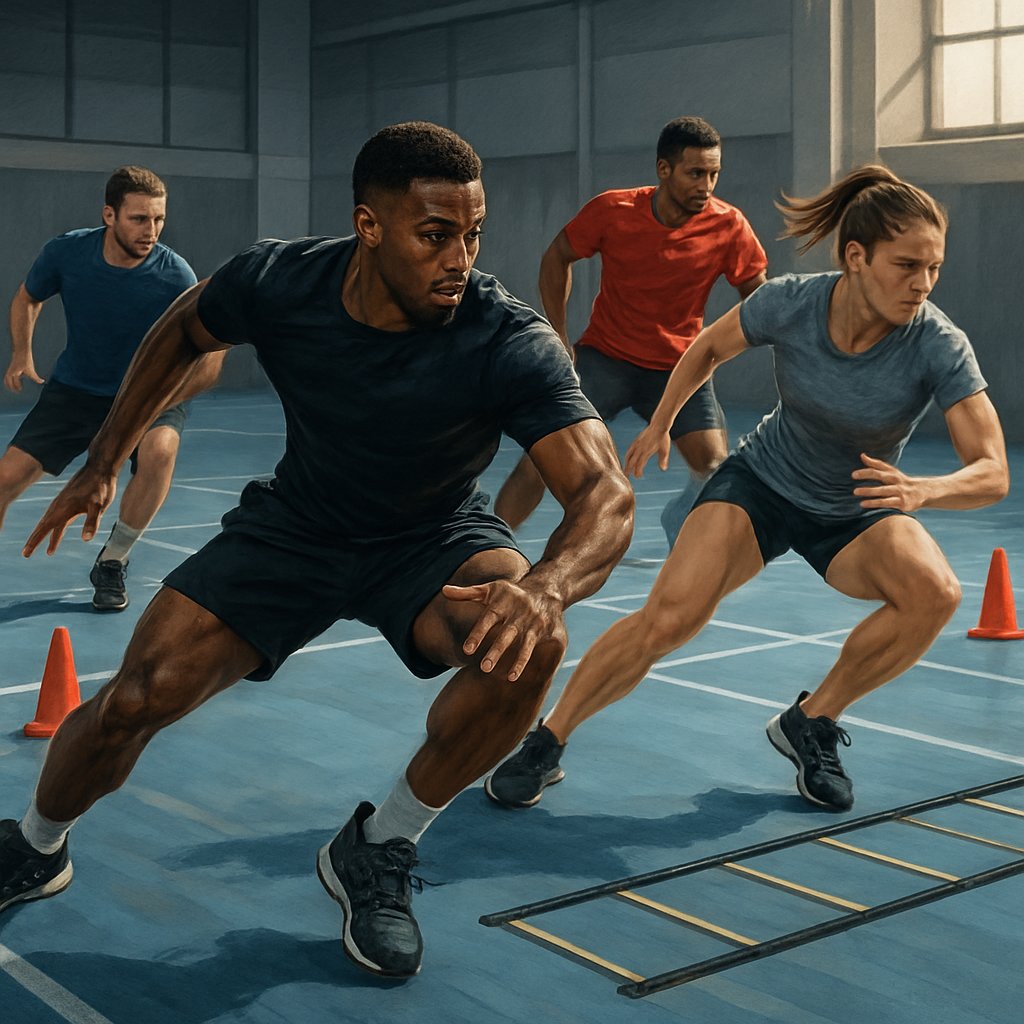
Strong movement and stability are the base for all those quick changes on court. You need good positioning, balance, and coordinated footwork.
Importance of Athletic Stance and Posture
Your athletic stance is your launchpad for every move. Stand with feet shoulder-width apart, knees bent, and your weight on the balls of your feet—not the heels.
Keep your back straight, lean forward a bit, and stay ready. Arms should hang relaxed, ready to help you balance.
A solid stance helps you react faster. Stay low and balanced, and you can change direction without wasted motion. Plus, it helps protect you from injury.
Hold this position for 30 seconds at a time when you practice. Try to stay relaxed and comfortable while keeping good form.
Techniques for Enhancing Balance and Stability
Single-leg exercises build the stability you need. Stand on one foot for 30 seconds, then switch. Make it tougher by closing your eyes or standing on something unstable.
Core work is big for stability. A strong core keeps you balanced during quick turns and stops. Planks and side planks are simple but effective.
Dynamic balance drills are more game-like. Walking lunges or single-leg reaches teach your body to stay steady while moving.
Squeeze in balance work 2-3 times a week. Start easy, then ramp up as you get better.
Developing Quick Footwork and Lateral Movement
Ladder drills crank up your foot speed and coordination. Try patterns like two feet in each square or quick side steps. Keep your steps light and snappy.
Lateral shuffles build your sideways game. Stay low, slide your feet (don’t cross them), and keep your knees bent.
Cone drills teach you to change direction fast. Set up cones in different shapes and practice moving between them. Aim for sharp cuts and explosive starts.
Keep your footwork light and under control. Heavy steps just slow you down and waste energy. Ten to fifteen minutes per session is plenty for these drills.
Core Drills to Improve Speed and Direction Changes
Incorporating drills focused on improving court speed and agility can significantly impact your effectiveness on the field or court.
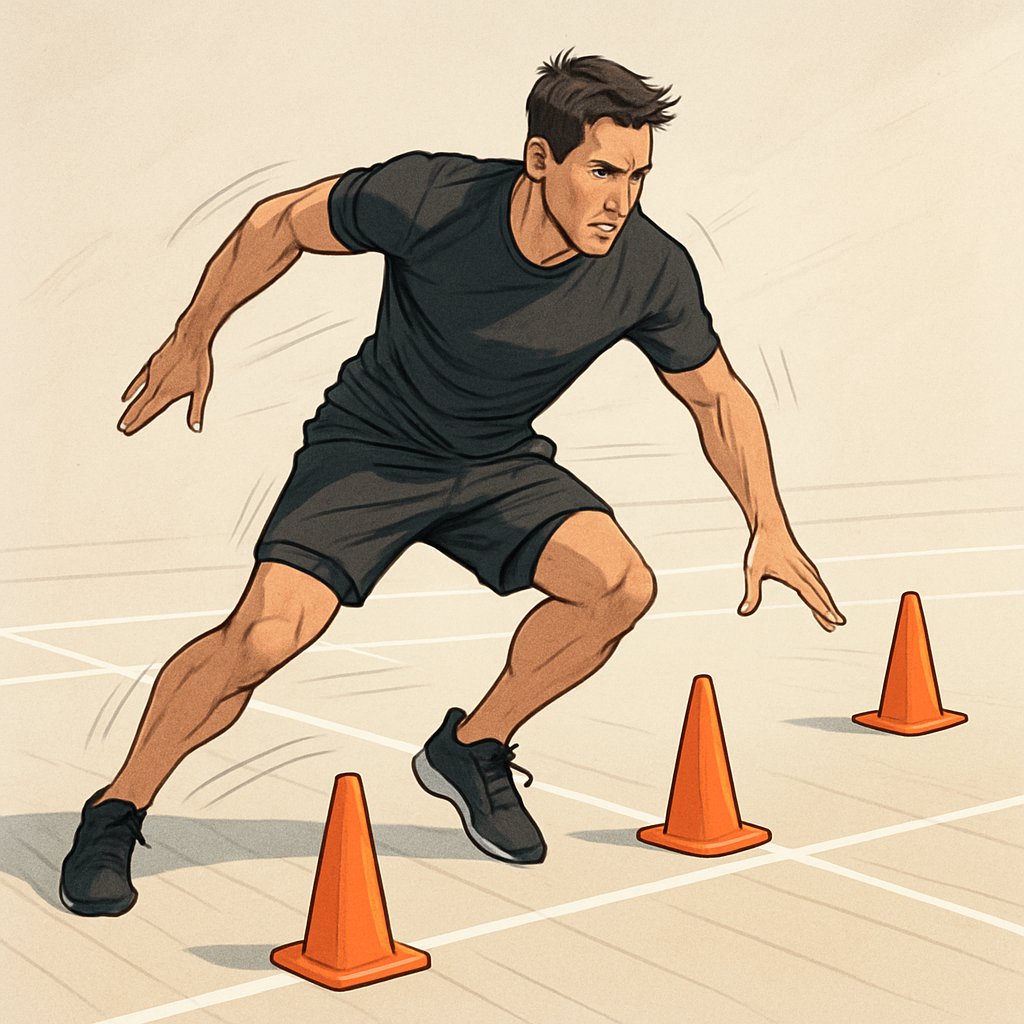
Using effective drills can greatly improve your court speed and agility.
These drills build foot speed, acceleration control, and quick direction changes—basically, everything you need for court sports. Each drill type targets a specific skill that directly helps your game.
To achieve peak performance, dedicated practice targeting your court speed and agility will pay off in competitive situations.
Consider integrating these drills into your routine for better court speed and agility.
Ladder Drills for Foot Speed and Coordination
Ladder drills are all about fast feet and better coordination. You can use an agility ladder or just chalk lines spaced about 18 inches apart.
Basic ladder patterns:
- In-in-out-out: Step both feet in, then both feet out of each square
- Lateral shuffle: Move sideways through the ladder with quick steps
- Icky shuffle: Step in-out-in, alternating feet in each square
Do each pattern for 30 seconds, then rest for 15 seconds. Stay light on your feet and keep movements quick but controlled.
Start slow to nail the pattern. Speed will come naturally as you get the hang of it.
Regular practice will enhance your overall court speed and agility.
Cone Drills for Acceleration and Deceleration
Cone drills help you speed up and slow down in control. Space cones 5-10 yards apart, depending on your level.
These cone drills significantly boost your court speed and agility.
Try these variations:
- 5-10-5 shuffle: Sprint 5 yards right, 10 left, then 5 right again
- T-drill: Sprint forward, shuffle side-to-side, then backpedal
- Box drill: Make a square and work on explosive direction changes
When slowing down, plant your outside foot and drop your hips to change direction safely.
Do 3-5 reps of each drill, resting fully in between. Focus on quality, not just speed.
Shuttle Runs and the Spider Drill
Shuttle runs build endurance and practice direction changes while you’re tired. The spider drill adds lots of direction changes in one sequence.
Shuttle runs also contribute to improving your court speed and agility.
Spider drill setup: Place five cones in a plus sign, each 5 yards from the center.
Start at the center. Sprint to each outer cone and return to center each time. Touch every cone with your hand and work on quick pivots.
Try to finish the whole sequence in under 25 seconds. Rest for about a minute before going again.
Agility Tests and Tracking Progress
Testing helps you see improvement and spot what needs work. Use standard agility tests every few weeks to measure your progress.
Good tests:
-
- Pro agility (5-10-5): Checks lateral quickness
- T-test: Looks at multi-directional speed
Tracking your progress in court speed and agility will aid in focused improvements.
- Hexagon test: Measures rapid direction changes
Write down your times and track your progress over 4-6 week blocks. Even shaving off a tenth of a second means you’re getting quicker.
Building Explosive Power and Strength
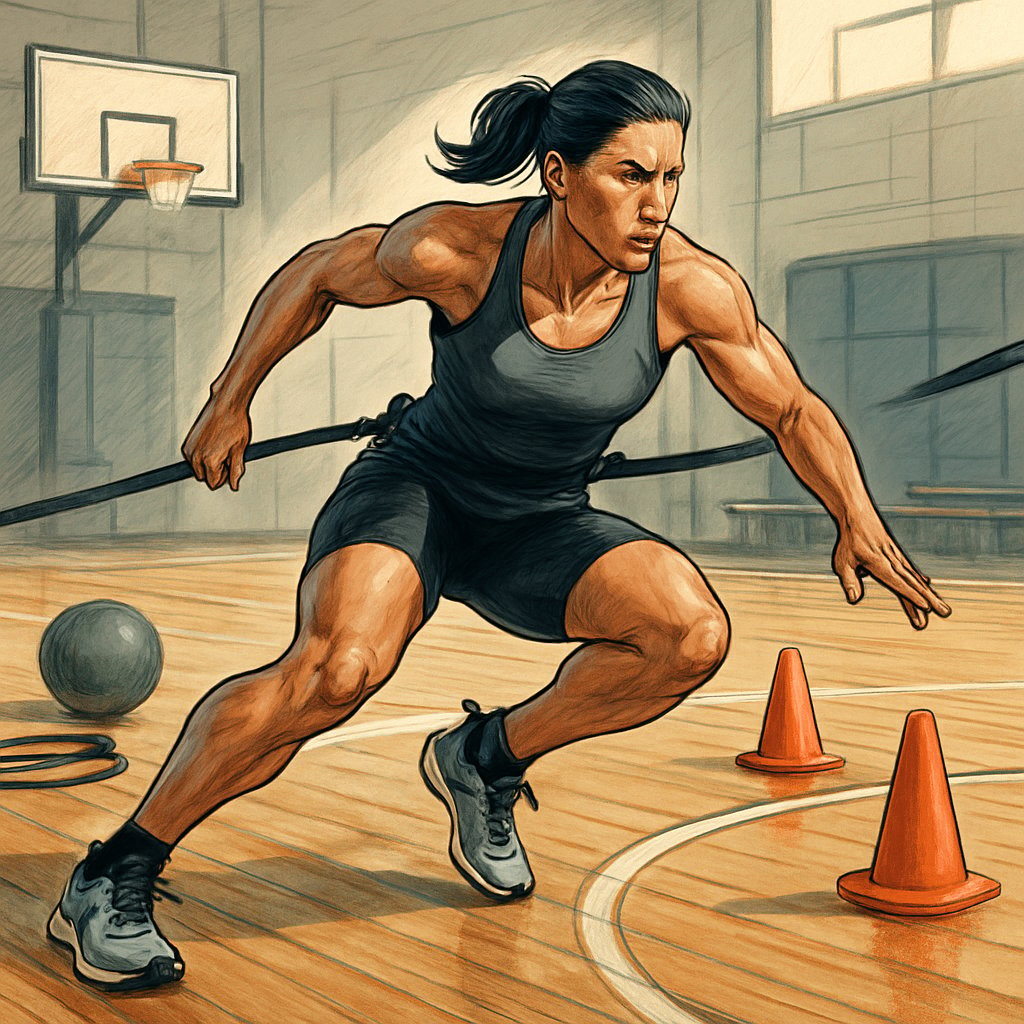
Enhancing your court speed and agility is vital for competitive success.
Remember, your commitment to improving court speed and agility will determine your success in high-pressure scenarios.
Explosive power comes from fast muscle contractions paired with solid strength work. Plyometrics fire up the stretch-shortening cycle, bands add resistance, and strength training builds your base.
Plyometric Exercises and Box Jumps
Box jumps are a go-to for explosive leg strength. Start with a 12-18 inch box and focus on landing soft with bent knees.
The stretch-shortening cycle is when your muscles stretch quickly then snap back. That creates more power than just regular contractions.
Core Plyometric Moves:
Plyometric exercises help develop explosive power for court speed and agility.
- Box jumps (3 sets of 8-10)
- Depth jumps from 18-24 inches
- Lateral bounds for side-to-side power
- Single-leg hops for balance
Jump up with both feet. Step down gently—don’t jump off the box, it’s not worth the risk. Rest 60-90 seconds between sets to keep your jumps explosive.
Raise the box height by 2-4 inches every couple weeks if you’re feeling good. Give your muscles time to adapt.
Resistance Band Techniques for Strength and Stability
Resistance bands build strength and stability by fighting against you the more you move.
Try these band moves:
- Lateral walks – Step sideways with a band around your ankles
- Monster walks – Forward and backward steps with the band
- Band-assisted jumps – Bands help you jump higher
- Resisted sprints – Sprint with the band holding you back
For lateral walks, put a mini-band around your ankles and take 15-20 steps each way. Keep your knees bent and tension in the band.
Band-assisted jumps let you practice explosive movement with a little help. The band takes some weight off, so you can go higher.
Incorporating Strength Training for Explosive Starts
Incorporating agility work into your training will enhance your court speed and agility.
Strength training lays the groundwork for explosive starts. Focus on compound lifts that hit several muscle groups at once.
Key Strength Moves:
-
- Squats (3 sets of 6-8 reps at 80% of your max)
To elevate your court speed and agility, focus on strength training that enhances your explosiveness and responsiveness.
- Deadlifts for your backside muscles
- Bulgarian split squats for single-leg power
- Calf raises for that push-off pop
Squat with feet shoulder-width. Lower until your thighs are parallel, then drive up hard through your heels.
Train strength 2-3 times a week, leaving at least a day between sessions. Muscles need recovery to grow.
Pair heavy squats with explosive starts. Do 3 heavy squats, then immediately practice 3 explosive starts from your sport position.
Striving for better court speed and agility will set you apart from competitors.
Comprehensive Training Routines and Injury Prevention
A comprehensive approach to training will help solidify your court speed and agility, ensuring you remain a step ahead of your competition.
Implementing a comprehensive routine will enhance your court speed and agility.
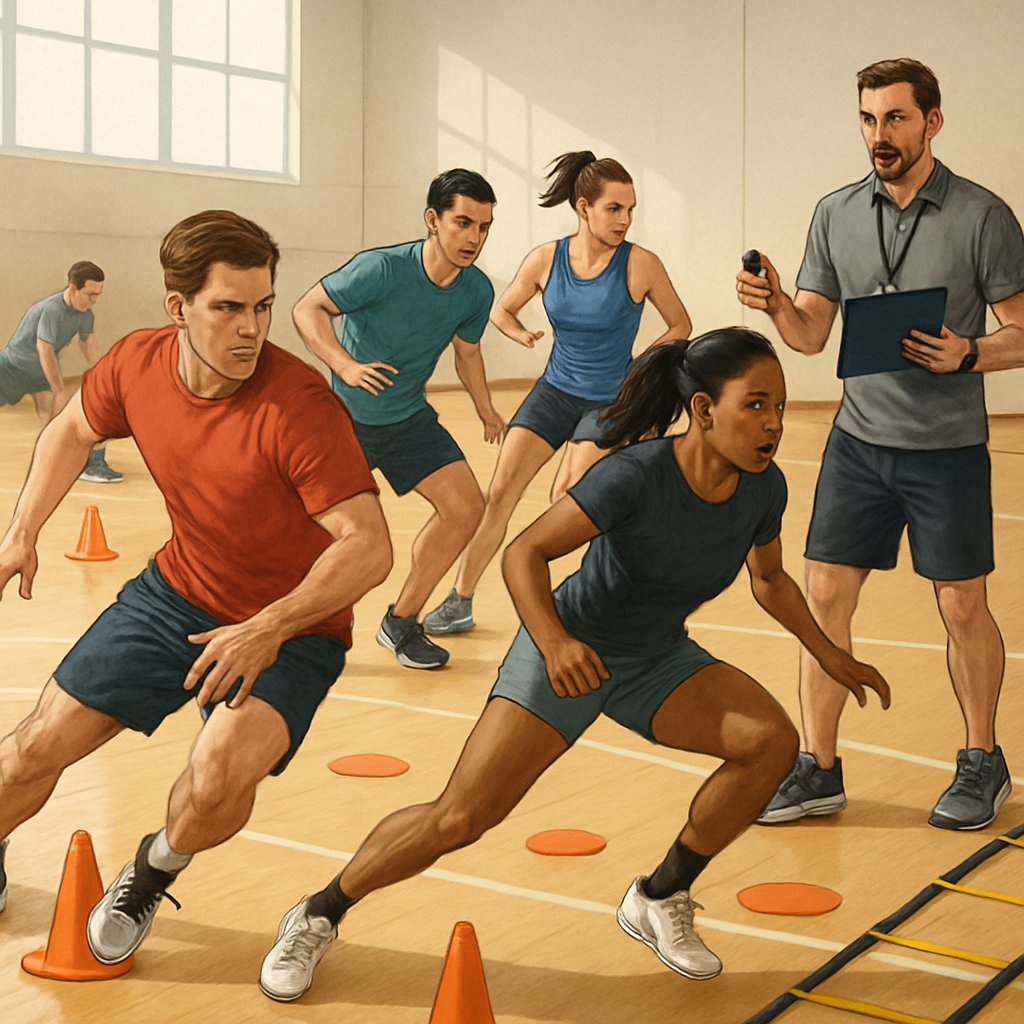
A smart training routine, with dynamic stretching and recovery, cuts injury risk and boosts court performance. Progression builds strength and coordination to protect your joints during fast changes.
Building a Progressive Agility Training Routine
Start with the basics, then ramp up the complexity. In week one, stick with ladder drills and cone work at about half speed.
Weekly Progression:
-
- Weeks 1-2: Basic ladder and cone drills
Focusing on court speed and agility drills from the start will yield great results.
- Weeks 3-4: Add resistance bands, bump up speed to 70%
- Weeks 5-6: Mix in complex patterns and plyometric jumps
- Weeks 7-8: Go full intensity with sport-specific moves
Train agility 3-4 times a week, with rest days in between. Keep sessions to 20-30 minutes to avoid burning out.
Balancing strength training with court speed and agility work is essential for success.
Agility training works several muscle groups at once. That kind of functional strength translates right onto the court.
Key Training Pieces:
-
- Ladder drills for fast feet
Regularly tracking your progress related to court speed and agility will keep you motivated and focused on your goals.
-
- Cone patterns for direction changes
- Box jumps for explosive power
Incorporating band work will help with your court speed and agility training.
- Band work for stability
Track your progress to dial in your intensity. Write down your times and note how your movement quality improves.
Dynamic Stretching for Preparation and Recovery
Dynamic stretching gets your joints ready for quick moves. Do these before every training session or game.
Your dynamic warm-up should prepare you for maintaining court speed and agility.
Pre-Training Dynamic Warm-up:
-
- Leg swings (10 each direction)
- High knees (30 seconds)
Improving your court speed and agility requires dedication, but the results will be evident in your overall athletic performance.
- Butt kicks (30 seconds)
- Walking lunges (10 each leg)
- Ankle circles (10 each direction)
These warm-ups boost blood flow to your muscles. You’ll move your joints through a full range of motion, but without holding any stretch.
After workouts, shift to static stretches. Hold each stretch for 30 seconds.
Cool-down stretches focus on flexibility. Target your calves, hamstrings, hip flexors, and quads after tough sessions.
These recovery strategies will help you come back stronger for court speed and agility.
Endurance, Recovery, and Injury Prevention Strategies
Court sports need both speed and stamina. Try 20-30 minutes of steady cardio twice a week to build your aerobic base.
Balancing endurance with explosive movements enhances court speed and agility.
Take a full rest day from agility training each week. Proper recovery helps you avoid overuse injuries.
Recovery Methods:
- Get 7-8 hours of sleep every night
- Use a foam roller after workouts
- Take ice baths after really hard training days
- Stay hydrated all day
Pay attention to warning signs from your body. If joint pain or muscle soreness sticks around for more than 48 hours, don’t ignore it.
Strength training makes your joints more stable. Focus on single-leg moves that mimic real court actions.
Increase training intensity slowly. Jumping straight from easy to max effort isn’t worth the risk.
Frequently Asked Questions
Understanding agility’s role will improve your court speed and agility during competition.
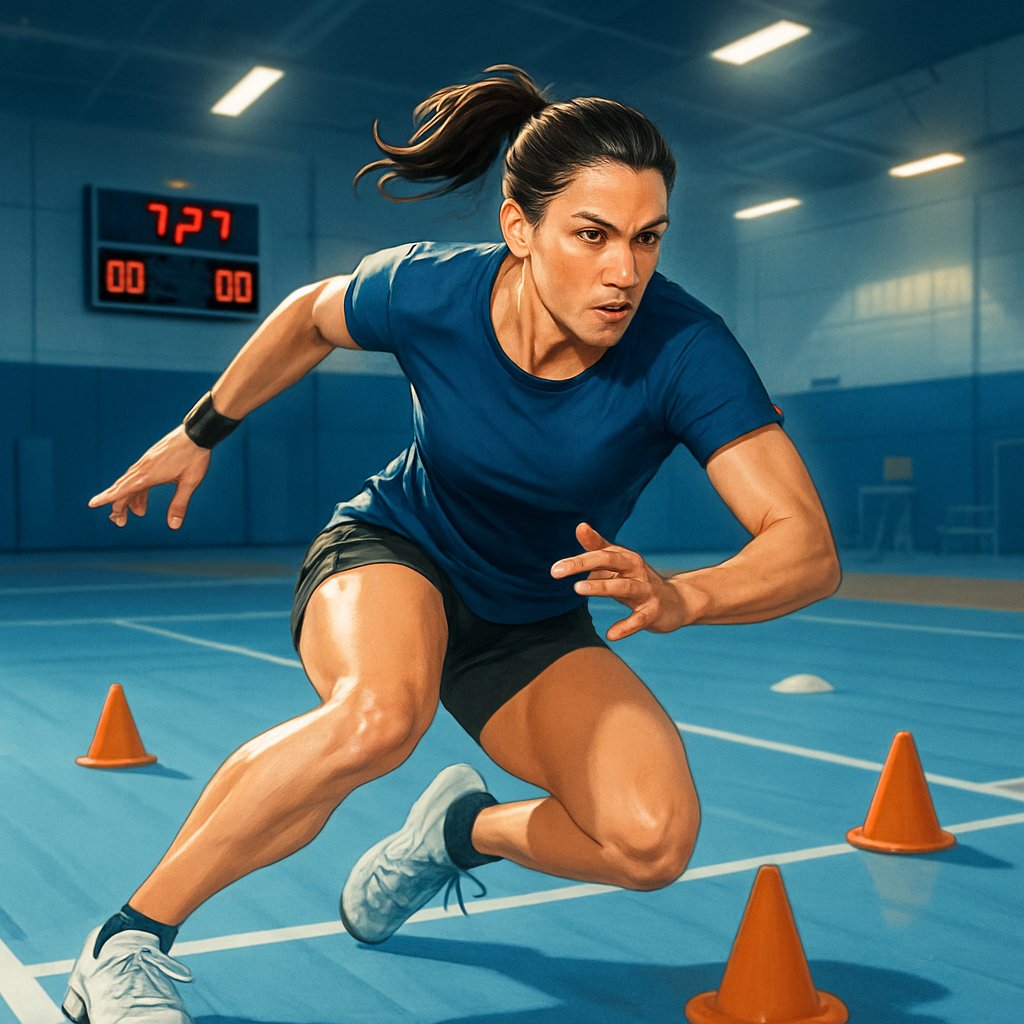
Athletes ask a lot about how to train for better direction changes. They want to know which drills work for kids, how to train at home, how to fit everything into a program, and what actually helps their sport performance.
What drills effectively enhance change of direction skills in youth athletes?
Ladder drills are great for foot speed and coordination. Start with simple two-feet-in patterns or lateral shuffles to build a base.
Cone drills teach safe direction changes. Try basic 5-10-5 shuttles or T-drills using cones spaced 5 yards apart.
Box jumps help with explosive power for quick cuts. Use low boxes (6-12 inches) so kids can focus on good form.
Agility exercises enhance your court speed and agility both at home and in the gym.
Side-to-side shuffles boost lateral movement. Set up two markers about 10 feet apart and have athletes shuffle back and forth.
Backpedal drills teach control moving backward. Practice short 10-yard backpedals, then sprint forward.
Which agility exercises can be performed at home to improve quick direction changes?
Shadow boxing is an easy way to work on reaction time and footwork. Move in different directions while throwing punches—no gear needed.
Stair climbing builds leg strength for explosive moves. Run up stairs two at a time or do lateral step-ups.
Jump rope is classic for foot speed and coordination. Try single-leg hops or side-to-side jumps to mix things up.
Wall sits target leg muscles for stability. Hold for 30-60 seconds to build some endurance.
Mirror drills work even in small spaces. Have a partner lead movements while you copy their direction changes.
Including court speed and agility drills in your training will lead to better performance.
How can an athlete incorporate speed and agility work into their training regimen?
Plan agility training 2-3 times a week, but not on back-to-back days. Your body needs time to recover.
Do agility drills early in your workout while you’re still fresh. Tired muscles can’t move as fast or as precisely.
Mix agility with skills from your sport. Practice direction changes while dribbling or catching.
Try using agility work as active recovery between heavy strength days. Light movement keeps skills sharp and helps recovery.
Ramp up difficulty slowly. Start simple, then add speed or reaction elements as you improve.
What are the components of an effective speed and agility training program?
You’ll want straight-line sprints at different distances—10 to 40 yards works well.
Training in all directions matters too. Practice forward, backward, lateral, and diagonal movements.
Reaction drills help you respond faster. Use lights or someone’s voice to cue your movement.
Strength training and agility drills together support optimal court speed and agility.
Strength training is key for explosive power. Focus on single-leg moves and plyometrics.
Don’t skip warm-ups, cool-downs, or rest days. Recovery keeps you healthy and improving.
How do change of direction drills benefit football players specifically?
Cutting helps players get away from defenders. Sharp changes let runners break free.
Lateral movement training boosts defensive positioning. Players can better keep up with opponents during routes or moves.
Football demands quick acceleration from all sorts of stances. Working on this in practice pays off in games.
Good balance and stability cut down on injuries during contact. Better body control means fewer ankle and knee issues on cuts.
What is the role of agility in enabling athletes to perform quick direction changes during competition?
Agility training sharpens the coordination between your brain and muscles. That means you can react faster when the game suddenly shifts.
When athletes develop better body awareness, they keep their balance during those wild, rapid moves. With sharper proprioception, it’s a lot easier to avoid awkward landings or those embarrassing falls.
Improving your agility translates to better court speed and agility, enhancing performance.
Learning to decelerate smoothly lets you stop on a dime before cutting or pivoting. That control is absolutely essential for quick, sharp changes in direction.
Athletes who build up the ability to produce force in all directions end up moving more explosively. They can generate power no matter how twisted or off-balance their bodies get.
Building your court speed and agility will help you excel in your sport.
